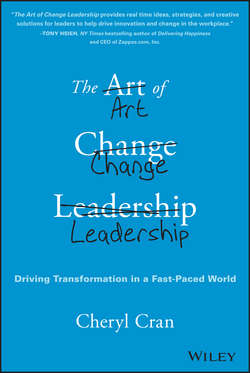Читать книгу The Art of Change Leadership - Cheryl Cran - Страница 9
На сайте Литреса книга снята с продажи.
Chapter 1
Why Do Organizations Need Change Leaders?
The Increasing Need for Innovation and Speed
ОглавлениеIn addition to the need for breakthrough and transformation, there is the ongoing reality of the speed of change and the need for rapid innovation. In the example of the AT&T Foundry a structure was created to focus on innovation as a main driver for the business. There is an opportunity for an organization of any size to create its own innovation hub. There are innovation hubs available for start-up companies, but what if existing companies created their own innovation hubs similar to AT&T's. An example of an innovation incubator is Innovation HUB – Florida Innovation HUB at the University of Florida. The mission of the Innovation HUB is as follows:
The Florida Innovation Hub was created to serve as catalyst for start-up companies whose technologies emanated from laboratories at the University of Florida and throughout the state. Our mission is to provide them with the infrastructure, logistics, and resources needed to get up and running effectively and efficiently. In doing so, the Innovation Hub hopes to help those companies and others bring research discoveries to the marketplace, creating additional jobs for Floridians.
The Florida Innovation HUB is modeled after successful entrepreneurial-focused commercialization centers. According to the National Business Incubation Association (NBIA), companies that graduate from a business incubator create jobs, revitalize neighborhoods and commercialize new technologies, thus strengthening local, regional, and national economies. Historically, NBIA member incubators have reported that 87 percent of all firms that have graduated from their incubators are still in business.
What is great about innovation centers such as the Florida HUB is that it provides a format for continual research and innovation. Many organizations say they want to be innovative and speedy and yet they have not created a format or environment for both of these things to be focused on. We need future focused change leaders who will not only question whether they have processes aligned with what the company and executives say they want to create but who will actually lead the change to create the solutions and the infrastructures to ensure that innovation is a consistent focus. The manufacturing industry has recognized the need for innovation hubs; in 2014, three Manufacturing Innovation Institutes were announced, each geared toward a particular field of manufacturing development and funded in a similar fashion. At North Carolina State University at Raleigh, an innovation hub known as the Next Generation Power Electronics National Manufacturing Innovation Institute was launched in January 2014 and tasked with improving energy efficiency. N.C. State and its partners will tackle the broad challenge by advancing the technology and production of special power-oriented semiconductors to improve efficiency in applications ranging from electronic devices to electric vehicles.
Innovation today is not innovation of the past. In the past, innovation was led by the senior leaders who would then report back to the employees about the innovations that were going to take place. Today, innovation requires open-source. Think Tesla and this excerpt from a June 12, 2014 blog post from Elon Musk on the philosophy of sharing for the sake of innovation:
Excerpt from All Our Patents Belong to You Elon Musk, CEO, June 12, 2014
If we clear a path to the creation of compelling electric vehicles, but then lay intellectual property landmines behind us to inhibit others, we are acting in a manner contrary to that goal. Tesla will not initiate patent lawsuits against anyone who, in good faith, wants to use our technology.
Elon Musk is an example of a change leader who is focused on the bigger picture of innovation and speed; his overwhelming objective is to have more electric cars a reality sooner than later.
So what if we applied Tesla's approach to innovation in our companies today? Innovation as a collaborative approach not only solves the transformation dilemma, it also creates greater engagement for all employees within the company. In order to create speedy innovation, it takes more than a few people; it takes a village. Steve Jobs acknowledged that he had creative vision and he was quick to state that he had a team of talented developers and creators that worked together and in a dynamic way that encouraged sharing ideas, challenging the ideas in a healthy way, and then sharing the innovation as quickly as they could to the market.
In fact, it is speedy innovation that keeps Apple as one of the world's top performing organizations. No sooner do they release a new version of the iPhone, they are consistently and constantly creating new products with new features that are right on target with the consumer needs. In fact, one of Apple's many successful business approaches is anticipating what the customer wants before he or she even knows they want it.
Innovation and speed is not limited to technology. You and I both know that technology needs humans to operate it (well, at least so far!). As change leaders who drive transformation, we as humans need to increase our speed of thinking, of linking unknown things together, of connecting with each other in helpful and productive ways, and in adding value to employees and customers. How? There will be more about that later on in the chapters that follow.
